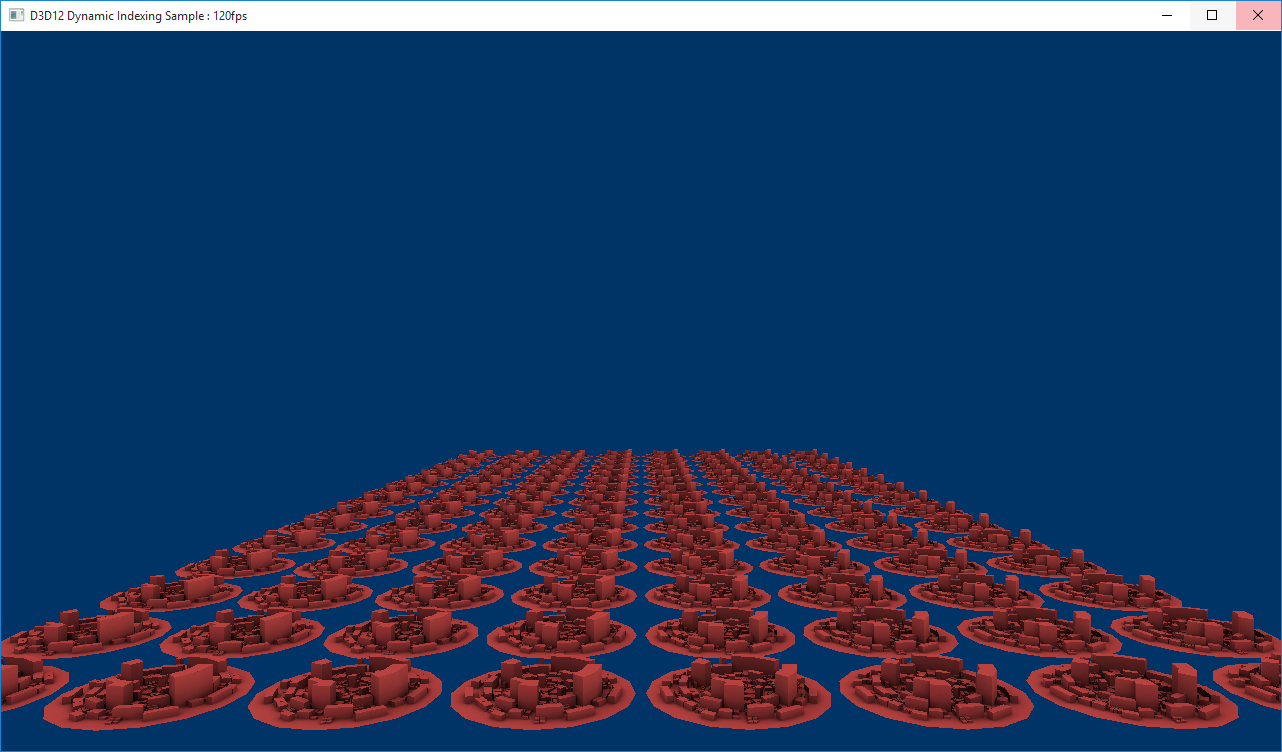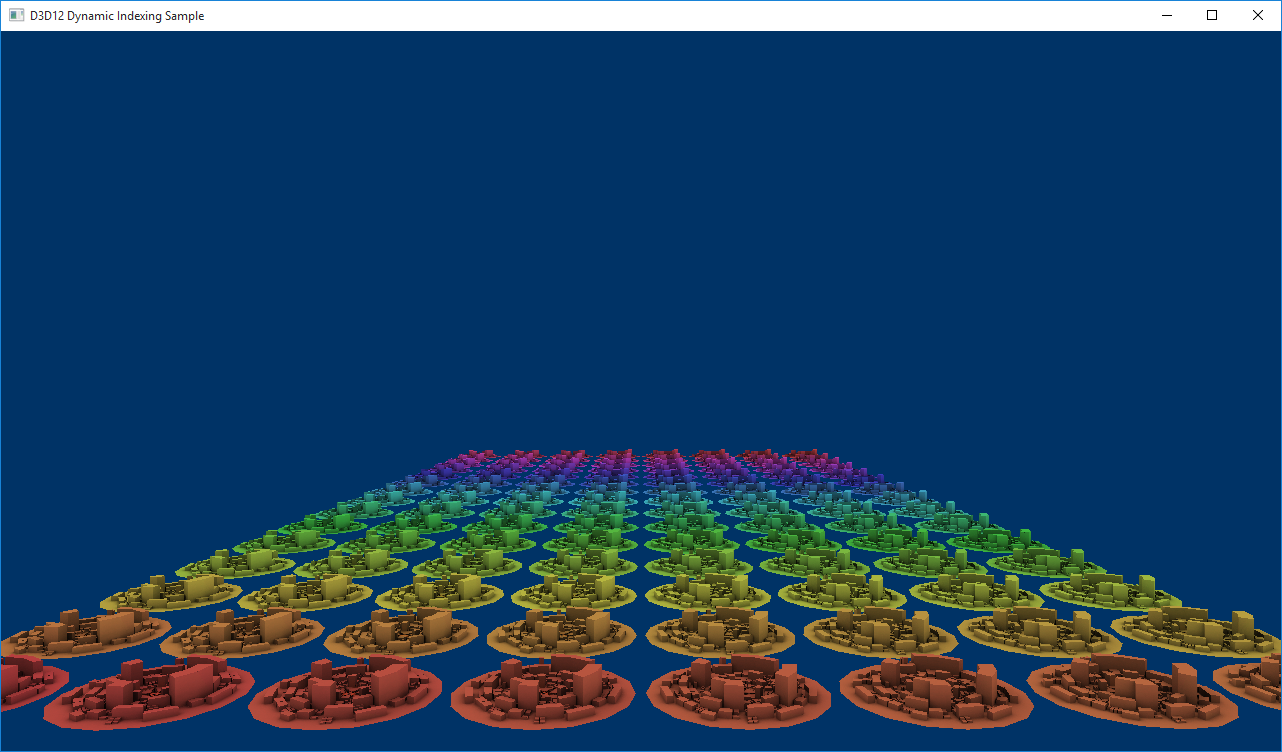Indexado dinámico mediante HLSL 5.1
En el ejemplo D3D12DynamicIndexing se muestran algunas de las nuevas características de HLSL disponibles en Shader Model 5.1 ( especialmente la indexación dinámica y las matrices sin enlazar) para representar la misma malla varias veces, cada vez que se representa con un material seleccionado dinámicamente. Con la indexación dinámica, los sombreadores ahora pueden indexar en una matriz sin conocer el valor del índice en tiempo de compilación. Cuando se combina con matrices sin enlazar, esto agrega otro nivel de direccionamiento indirecto y flexibilidad para los autores de sombreador y las canalizaciones de arte.
- Configurar el sombreador de píxeles
- Configuración de la firma raíz
- Creación de las texturas
- Carga de los datos de textura
- Carga de la textura difusa
- Creación de un sampler
- Cambiar dinámicamente el índice del parámetro raíz
- Ejecución del ejemplo
- Temas relacionados
Configurar el sombreador de píxeles
Echemos un vistazo primero al sombreador, que para este ejemplo es un sombreador de píxeles.
Texture2D g_txDiffuse : register(t0);
Texture2D g_txMats[] : register(t1);
SamplerState g_sampler : register(s0);
struct PSSceneIn
{
float4 pos : SV_Position;
float2 tex : TEXCOORD0;
};
struct MaterialConstants
{
uint matIndex; // Dynamically set index for looking up from g_txMats[].
};
ConstantBuffer<MaterialConstants> materialConstants : register(b0, space0);
float4 PSSceneMain(PSSceneIn input) : SV_Target
{
float3 diffuse = g_txDiffuse.Sample(g_sampler, input.tex).rgb;
float3 mat = g_txMats[materialConstants.matIndex].Sample(g_sampler, input.tex).rgb;
return float4(diffuse * mat, 1.0f);
}
La característica de matriz sin enlazar se ilustra mediante la g_txMats[] matriz, ya que no especifica un tamaño de matriz. La indexación dinámica se usa para indexar en g_txMats[] con matIndex, que se define como una constante raíz. El sombreador no tiene conocimiento del tamaño ni de la matriz ni del valor del índice en tiempo de compilación. Ambos atributos se definen en la firma raíz del objeto de estado de canalización usado con el sombreador.
Para aprovechar las características de indexación dinámica de HLSL, es necesario que el sombreador se compile con SM 5.1. Además, para usar matrices sin enlazar, también se debe usar la marca /enable_unbounded_descriptor_tables . Las siguientes opciones de línea de comandos se usan para compilar este sombreador con effect-compiler Tool (FXC):
fxc /Zi /E"PSSceneMain" /Od /Fo"dynamic_indexing_pixel.cso" /ps"_5_1" /nologo /enable_unbounded_descriptor_tables
Configuración de la firma raíz
Ahora, echemos un vistazo a la definición de firma raíz, especialmente, cómo definimos el tamaño de la matriz sin enlazar y vincular una constante raíz a matIndex. Para el sombreador de píxeles, definimos tres cosas: una tabla de descriptores para SRV (nuestras Texture2Ds), una tabla descriptor para Samplers y una única constante raíz. La tabla descriptor de nuestros SRV contiene CityMaterialCount + 1 entradas.
CityMaterialCount es una constante que define la longitud de g_txMats[] y el + 1 es para g_txDiffuse. La tabla descriptor de nuestros samplers contiene solo una entrada y solo definimos un valor constante raíz de 32 bits a través de InitAsConstants(...)., en el método LoadAssets .
// Create the root signature.
{
CD3DX12_DESCRIPTOR_RANGE ranges[3];
ranges[0].Init(D3D12_DESCRIPTOR_RANGE_TYPE_SRV, 1 + CityMaterialCount, 0); // Diffuse texture + array of materials.
ranges[1].Init(D3D12_DESCRIPTOR_RANGE_TYPE_SAMPLER, 1, 0);
ranges[2].Init(D3D12_DESCRIPTOR_RANGE_TYPE_CBV, 1, 0);
CD3DX12_ROOT_PARAMETER rootParameters[4];
rootParameters[0].InitAsDescriptorTable(1, &ranges[0], D3D12_SHADER_VISIBILITY_PIXEL);
rootParameters[1].InitAsDescriptorTable(1, &ranges[1], D3D12_SHADER_VISIBILITY_PIXEL);
rootParameters[2].InitAsDescriptorTable(1, &ranges[2], D3D12_SHADER_VISIBILITY_VERTEX);
rootParameters[3].InitAsConstants(1, 0, 0, D3D12_SHADER_VISIBILITY_PIXEL);
CD3DX12_ROOT_SIGNATURE_DESC rootSignatureDesc;
rootSignatureDesc.Init(_countof(rootParameters), rootParameters, 0, nullptr, D3D12_ROOT_SIGNATURE_FLAG_ALLOW_INPUT_ASSEMBLER_INPUT_LAYOUT);
ComPtr<ID3DBlob> signature;
ComPtr<ID3DBlob> error;
ThrowIfFailed(D3D12SerializeRootSignature(&rootSignatureDesc, D3D_ROOT_SIGNATURE_VERSION_1, &signature, &error));
ThrowIfFailed(m_device->CreateRootSignature(0, signature->GetBufferPointer(), signature->GetBufferSize(), IID_PPV_ARGS(&m_rootSignature)));
}
Creación de las texturas
El contenido de g_txMats[] son texturas generadas por procedimientos creadas en LoadAssets. Cada ciudad representada en la escena comparte la misma textura difusa, pero cada una también tiene su propia textura generada por procedimientos. La matriz de texturas abarca el espectro arco iris para visualizar fácilmente la técnica de indexación.
// Create the textures and sampler.
{
// Procedurally generate an array of textures to use as city materials.
{
// All of these materials use the same texture desc.
D3D12_RESOURCE_DESC textureDesc = {};
textureDesc.MipLevels = 1;
textureDesc.Format = DXGI_FORMAT_R8G8B8A8_UNORM;
textureDesc.Width = CityMaterialTextureWidth;
textureDesc.Height = CityMaterialTextureHeight;
textureDesc.Flags = D3D12_RESOURCE_FLAG_NONE;
textureDesc.DepthOrArraySize = 1;
textureDesc.SampleDesc.Count = 1;
textureDesc.SampleDesc.Quality = 0;
textureDesc.Dimension = D3D12_RESOURCE_DIMENSION_TEXTURE2D;
// The textures evenly span the color rainbow so that each city gets
// a different material.
float materialGradStep = (1.0f / static_cast<float>(CityMaterialCount));
// Generate texture data.
vector<vector<unsigned char>> cityTextureData;
cityTextureData.resize(CityMaterialCount);
for (int i = 0; i < CityMaterialCount; ++i)
{
CD3DX12_HEAP_PROPERTIES heapProps(D3D12_HEAP_TYPE_DEFAULT);
ThrowIfFailed(m_device->CreateCommittedResource(
&heapProps,
D3D12_HEAP_FLAG_NONE,
&textureDesc,
D3D12_RESOURCE_STATE_COPY_DEST,
nullptr,
IID_PPV_ARGS(&m_cityMaterialTextures[i])));
// Fill the texture.
float t = i * materialGradStep;
cityTextureData[i].resize(CityMaterialTextureWidth * CityMaterialTextureHeight * CityMaterialTextureChannelCount);
for (int x = 0; x < CityMaterialTextureWidth; ++x)
{
for (int y = 0; y < CityMaterialTextureHeight; ++y)
{
// Compute the appropriate index into the buffer based on the x/y coordinates.
int pixelIndex = (y * CityMaterialTextureChannelCount * CityMaterialTextureWidth) + (x * CityMaterialTextureChannelCount);
// Determine this row's position along the rainbow gradient.
float tPrime = t + ((static_cast<float>(y) / static_cast<float>(CityMaterialTextureHeight)) * materialGradStep);
// Compute the RGB value for this position along the rainbow
// and pack the pixel value.
XMVECTOR hsl = XMVectorSet(tPrime, 0.5f, 0.5f, 1.0f);
XMVECTOR rgb = XMColorHSLToRGB(hsl);
cityTextureData[i][pixelIndex + 0] = static_cast<unsigned char>((255 * XMVectorGetX(rgb)));
cityTextureData[i][pixelIndex + 1] = static_cast<unsigned char>((255 * XMVectorGetY(rgb)));
cityTextureData[i][pixelIndex + 2] = static_cast<unsigned char>((255 * XMVectorGetZ(rgb)));
cityTextureData[i][pixelIndex + 3] = 255;
}
}
}
}
| Flujo de llamadas | Parámetros |
|---|---|
| D3D12_RESOURCE_DESC |
D3D12_RESOURCE_FLAGS [D3D12_RESOURCE_DIMENSION] (/windows/desktop/api/d3d12/ne-d3d12-d3d12_resource_dimension) |
| CreateCommittedResource |
D3D12_HEAP_TYPE [D3D12_HEAP_FLAG] (/windows/desktop/api/d3d12/ne-d3d12-d3d12_heap_flags) CD3DX12_RESOURCE_DESC [D3D12_RESOURCE_STATES] (/windows/desktop/api/d3d12/ne-d3d12-d3d12_resource_states) |
| XMVECTOR |
[XMColorHSLToRGB] (/windows/desktop/api/directxmath/nf-directxmath-xmcolorhsltorgb) |
Carga de los datos de textura
Los datos de textura se cargan en la GPU a través de un montón de carga y los SRV se crean para cada uno y se almacenan en un montón de descriptores SRV.
// Upload texture data to the default heap resources.
{
const UINT subresourceCount = textureDesc.DepthOrArraySize * textureDesc.MipLevels;
const UINT64 uploadBufferStep = GetRequiredIntermediateSize(m_cityMaterialTextures[0].Get(), 0, subresourceCount); // All of our textures are the same size in this case.
const UINT64 uploadBufferSize = uploadBufferStep * CityMaterialCount;
CD3DX12_HEAP_PROPERTIES uploadHeap(D3D12_HEAP_TYPE_UPLOAD);
auto uploadDesc = CD3DX12_RESOURCE_DESC::Buffer(uploadBufferSize);
ThrowIfFailed(m_device->CreateCommittedResource(
&uploadHeap,
D3D12_HEAP_FLAG_NONE,
&uploadDesc,
D3D12_RESOURCE_STATE_GENERIC_READ,
nullptr,
IID_PPV_ARGS(&materialsUploadHeap)));
for (int i = 0; i < CityMaterialCount; ++i)
{
// Copy data to the intermediate upload heap and then schedule
// a copy from the upload heap to the appropriate texture.
D3D12_SUBRESOURCE_DATA textureData = {};
textureData.pData = &cityTextureData[i][0];
textureData.RowPitch = static_cast<LONG_PTR>((CityMaterialTextureChannelCount * textureDesc.Width));
textureData.SlicePitch = textureData.RowPitch * textureDesc.Height;
UpdateSubresources(m_commandList.Get(), m_cityMaterialTextures[i].Get(), materialsUploadHeap.Get(), i * uploadBufferStep, 0, subresourceCount, &textureData);
auto barrier = CD3DX12_RESOURCE_BARRIER::Transition(m_cityMaterialTextures[i].Get(), D3D12_RESOURCE_STATE_COPY_DEST, D3D12_RESOURCE_STATE_PIXEL_SHADER_RESOURCE);
m_commandList->ResourceBarrier(1, &barrier);
}
}
| Flujo de llamadas | Parámetros |
|---|---|
| GetRequiredIntermediateSize | |
| CreateCommittedResource | |
| D3D12_SUBRESOURCE_DATA | |
| UpdateSubresources | |
| ResourceBarrier |
Carga de la textura difusa
La textura difusa, g_txDiffuse, se carga de forma similar y también obtiene su propio SRV, pero los datos de textura ya están definidos en occcity.bin.
// Load the occcity diffuse texture with baked-in ambient lighting.
// This texture will be blended with a texture from the materials
// array in the pixel shader.
{
D3D12_RESOURCE_DESC textureDesc = {};
textureDesc.MipLevels = SampleAssets::Textures[0].MipLevels;
textureDesc.Format = SampleAssets::Textures[0].Format;
textureDesc.Width = SampleAssets::Textures[0].Width;
textureDesc.Height = SampleAssets::Textures[0].Height;
textureDesc.Flags = D3D12_RESOURCE_FLAG_NONE;
textureDesc.DepthOrArraySize = 1;
textureDesc.SampleDesc.Count = 1;
textureDesc.SampleDesc.Quality = 0;
textureDesc.Dimension = D3D12_RESOURCE_DIMENSION_TEXTURE2D;
CD3DX12_HEAP_PROPERTIES heapProps(D3D12_HEAP_TYPE_DEFAULT);
ThrowIfFailed(m_device->CreateCommittedResource(
&heapProps,
D3D12_HEAP_FLAG_NONE,
&textureDesc,
D3D12_RESOURCE_STATE_COPY_DEST,
nullptr,
IID_PPV_ARGS(&m_cityDiffuseTexture)));
const UINT subresourceCount = textureDesc.DepthOrArraySize * textureDesc.MipLevels;
const UINT64 uploadBufferSize = GetRequiredIntermediateSize(m_cityDiffuseTexture.Get(), 0, subresourceCount);
CD3DX12_HEAP_PROPERTIES uploadHeap(D3D12_HEAP_TYPE_UPLOAD);
auto uploadDesc = CD3DX12_RESOURCE_DESC::Buffer(uploadBufferSize);
ThrowIfFailed(m_device->CreateCommittedResource(
&uploadHeap,
D3D12_HEAP_FLAG_NONE,
&uploadDesc,
D3D12_RESOURCE_STATE_GENERIC_READ,
nullptr,
IID_PPV_ARGS(&textureUploadHeap)));
// Copy data to the intermediate upload heap and then schedule
// a copy from the upload heap to the diffuse texture.
D3D12_SUBRESOURCE_DATA textureData = {};
textureData.pData = pMeshData + SampleAssets::Textures[0].Data[0].Offset;
textureData.RowPitch = SampleAssets::Textures[0].Data[0].Pitch;
textureData.SlicePitch = SampleAssets::Textures[0].Data[0].Size;
UpdateSubresources(m_commandList.Get(), m_cityDiffuseTexture.Get(), textureUploadHeap.Get(), 0, 0, subresourceCount, &textureData);
auto barrier = CD3DX12_RESOURCE_BARRIER::Transition(m_cityDiffuseTexture.Get(), D3D12_RESOURCE_STATE_COPY_DEST, D3D12_RESOURCE_STATE_PIXEL_SHADER_RESOURCE);
m_commandList->ResourceBarrier(1, &barrier);
}
| Flujo de llamadas | Parámetros |
|---|---|
| D3D12_RESOURCE_DESC | |
| CreateCommittedResource | |
| GetRequiredIntermediateSize | |
| CreateCommittedResource | |
| D3D12_SUBRESOURCE_DATA | |
| ResourceBarrier |
Creación de un sampler
Por último, para LoadAssets, se crea un único sampler para muestrear a partir de la textura difusa o de la matriz de texturas.
// Describe and create a sampler.
D3D12_SAMPLER_DESC samplerDesc = {};
samplerDesc.Filter = D3D12_FILTER_MIN_MAG_MIP_LINEAR;
samplerDesc.AddressU = D3D12_TEXTURE_ADDRESS_MODE_WRAP;
samplerDesc.AddressV = D3D12_TEXTURE_ADDRESS_MODE_WRAP;
samplerDesc.AddressW = D3D12_TEXTURE_ADDRESS_MODE_WRAP;
samplerDesc.MinLOD = 0;
samplerDesc.MaxLOD = D3D12_FLOAT32_MAX;
samplerDesc.MipLODBias = 0.0f;
samplerDesc.MaxAnisotropy = 1;
samplerDesc.ComparisonFunc = D3D12_COMPARISON_FUNC_ALWAYS;
m_device->CreateSampler(&samplerDesc, m_samplerHeap->GetCPUDescriptorHandleForHeapStart());
// Create SRV for the city's diffuse texture.
CD3DX12_CPU_DESCRIPTOR_HANDLE srvHandle(m_cbvSrvHeap->GetCPUDescriptorHandleForHeapStart(), 0, m_cbvSrvDescriptorSize);
D3D12_SHADER_RESOURCE_VIEW_DESC diffuseSrvDesc = {};
diffuseSrvDesc.Shader4ComponentMapping = D3D12_DEFAULT_SHADER_4_COMPONENT_MAPPING;
diffuseSrvDesc.Format = SampleAssets::Textures->Format;
diffuseSrvDesc.ViewDimension = D3D12_SRV_DIMENSION_TEXTURE2D;
diffuseSrvDesc.Texture2D.MipLevels = 1;
m_device->CreateShaderResourceView(m_cityDiffuseTexture.Get(), &diffuseSrvDesc, srvHandle);
srvHandle.Offset(m_cbvSrvDescriptorSize);
// Create SRVs for each city material.
for (int i = 0; i < CityMaterialCount; ++i)
{
D3D12_SHADER_RESOURCE_VIEW_DESC materialSrvDesc = {};
materialSrvDesc.Shader4ComponentMapping = D3D12_DEFAULT_SHADER_4_COMPONENT_MAPPING;
materialSrvDesc.Format = DXGI_FORMAT_R8G8B8A8_UNORM;
materialSrvDesc.ViewDimension = D3D12_SRV_DIMENSION_TEXTURE2D;
materialSrvDesc.Texture2D.MipLevels = 1;
m_device->CreateShaderResourceView(m_cityMaterialTextures[i].Get(), &materialSrvDesc, srvHandle);
srvHandle.Offset(m_cbvSrvDescriptorSize);
}
Cambiar dinámicamente el índice del parámetro raíz
Si fueramos a representar la escena ahora, todas las ciudades aparecerían iguales, porque no hemos establecido el valor de nuestra constante raíz, matIndex. Cada sombreador de píxeles se indexaría en la 0ª ranura de g_txMats y la escena tendría este aspecto:

El valor de la constante raíz se establece en FrameResource::P opulateCommandLists. En el bucle for doble en el que se registra un comando draw para cada ciudad, registramos una llamada a SetGraphicsRoot32BitConstants que especifica nuestro índice de parámetros raíz en lo que respecta a la firma raíz ( en este caso 3 – el valor del índice dinámico y un desplazamiento– en este caso 0. Dado que la longitud de g_txMats es igual al número de ciudades que representamos, el valor del índice se establece incrementalmente para cada ciudad.
for (UINT i = 0; i < m_cityRowCount; i++)
{
for (UINT j = 0; j < m_cityColumnCount; j++)
{
pCommandList->SetPipelineState(pPso);
// Set the city's root constant for dynamically indexing into the material array.
pCommandList->SetGraphicsRoot32BitConstant(3, (i * m_cityColumnCount) + j, 0);
// Set this city's CBV table and move to the next descriptor.
pCommandList->SetGraphicsRootDescriptorTable(2, cbvSrvHandle);
cbvSrvHandle.Offset(cbvSrvDescriptorSize);
pCommandList->DrawIndexedInstanced(numIndices, 1, 0, 0, 0);
}
}
| Flujo de llamadas | Parámetros |
|---|---|
| SetPipelineState | |
| SetGraphicsRoot32BitConstant | |
| SetGraphicsRootDescriptorTable | |
| DrawIndexedInstanced |
Ejecución del ejemplo
Ahora, cuando representemos la escena, cada ciudad tendrá un valor diferente para matIndex y, por tanto, buscará una textura diferente para g_txMats[] la que la escena tenga un aspecto similar al siguiente:
